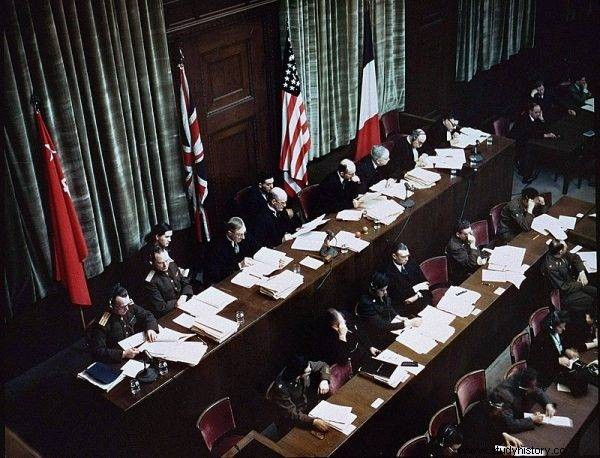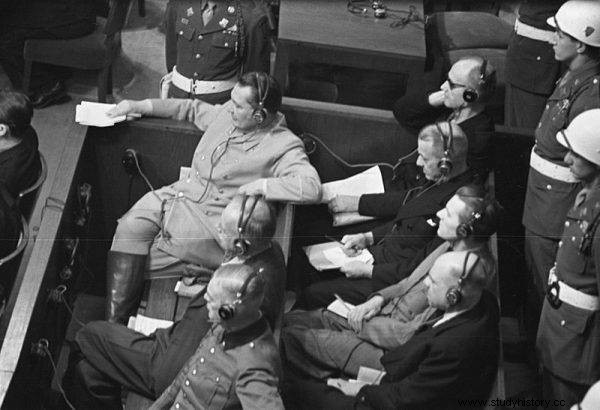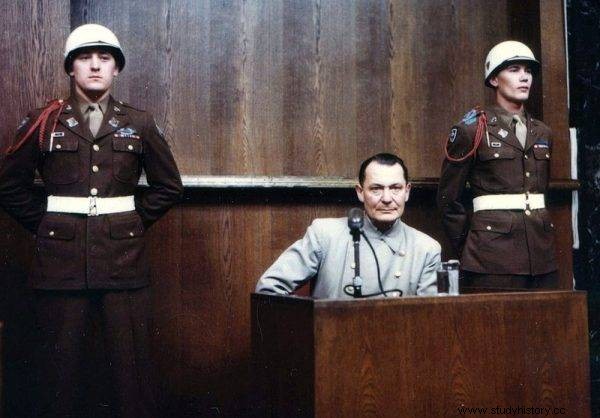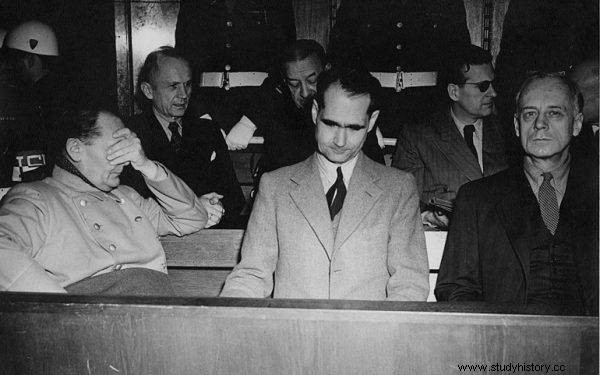What were the Nazis really like? During the Nuremberg trial, the Allies decided to examine psychiatrically captured Nazi criminals.
The Nuremberg trial was to serve a good cause. They wanted to show that the Western world is a place of the rule of law. Anyone, even those accused of the worst crimes, could prove their innocence.
The huge emotional burden of the trial made its participants bear the burden of Nuremberg many years later. The seriousness of the debate was deepened by the shocking testimonies of witnesses, descriptions of the atrocities of the war and the reactions of the Nazis present in the room. The attitudes of the former leaders of the Third Reich were extremely different. Some showed no interest in the trial. Others made vulgar accusations. There was also a group of those who tried to whitewash and blame the crimes on others . All their reactions were closely watched by the psychiatrists and psychologists gathered in the room.
Your brain will tell you the truth
Nobody really imagined that the Nazis seated in the dock could avoid the noose. The sentence was established even before the start of the criminal proceedings. Nevertheless, the trial still attracted the attention of the whole world. The world's psychiatrists also showed great interest, though for a different reason than everyone else. For the first time in history, there was an opportunity to conduct a thorough scientific study of the minds of the country's leaders. Leaders responsible for crimes against humanity and the extermination of millions of lives.

The Nuremberg trial was to serve a good cause. They wanted to show that the western world is a place of the rule of law.
Even before the meeting in Nuremberg, the scientific community insisted that they could examine the brains of the accused Nazis posthumously . The academics recommended that any prisoners should be executed in such a way that the tissues of this delicate organ were not damaged:
A detailed knowledge of the personalities of these leaders would be valuable as a guide for those involved in the reorganization and re-education of Germany. In addition to psychiatric interviews, it would be desirable to perform a number of psychological tests, such as Rorschach. If the accused were sentenced to death, a detailed autopsy, especially of the brain, would be desirable . Therefore, the condemned man is called upon to be shot in the chest and not in the head.
As it turned out later, of all those sentenced to death, only Robert Ley's brain ended up on the autopsy table.
Source of evil
In normal criminal proceedings, psychiatrists and psychologists have one task:to assess the sanity of the accused and to determine whether the acts committed by the accused were the result of a mental illness. In Nuremberg, this issue was relegated to the background. The admission to the trial of Rudolf Hess, a person with obvious psychiatric problems, shows that the assessment of sanity was not the main goal of the doctors working in Nuremberg . The specialists sent to the prison were to advise prison guards and prosecutors. In addition, they were to ... strengthen the morale of prisoners (so that they would survive until the end of the trial and not commit suicide earlier).
The most interesting part of their job, however, was researching the minds of German leaders. The main specialists in this field were Douglas Kelley and Gustave Gilbert. On the basis of intelligence tests and Rorschach inkblots, direct conversations with the accused and observation of their behavior during the trial, psychiatrists were to determine what caused the evil in the minds of the Nazi leaders.

photo:Nationaal Archief - CC0 On the basis of tests, interviews with the accused and observation of their behavior during the trial, psychiatrists were to determine what caused the evil in the minds of the Nazi leaders.
Even before the Nuremberg trial began, there were many hypotheses about it. Some experts argued that evil lies simply in human nature, and that the Nazis' actions were only due to the lack of moral and legal restrictions. . Other voices said that the German political class was a gang of mentally ill degenerates . Despite the fact that doctors in Nuremberg spent many hours questioning defendants in tight prison cells (Kelley claimed he spoke for eighty hours with each defendant), the final result of the study was ... inconclusive.
One flew over the cuckoo's nest
The attitude of the doctors who conducted them had a huge impact on the results of the psychiatric tests in Nuremberg. Douglas Kelley and Gustave Gilbert were completely different from each other. In the beginning, they were able to reconcile their antagonisms. Later, however, their cooperation was far from perfect.
Kelley saw working in Nuremberg as another interesting assignment to complement his vast clinical experience. The Nazis were an interesting subject of research for him, and working with them kept him awake at night. He was a laid-back cynic who loved to show off his knowledge and eloquence in numerous interviews with the press. Gilbert, on the other hand, was rough and humorless.

In 1945, the Rorschach ink test was the latest hype among psychoanalysts.
But he was a man on a mission. He was born in New York to a poor Jewish family. He spent his early childhood in an orphanage. A difficult start in life did not prevent him from receiving a doctorate in psychology. Before being assigned to Nuremberg, he worked in the army, interrogating prisoners of war. He was determined to track down the people responsible for the Nazi crimes . He desperately wanted to describe the depravity of the German leadership. He genuinely hated the Nazis and considered them evil incarnate.
Kelley was an expert on Rorschach, but spoke little German. Gilbert, on the other hand, was fluent in the language, but had little knowledge of the inkblot test. Kelley came from a wealthy Californian family, and Gilbert was raised in poverty. All this meant that the results of the Nuremberg trials differed depending on which psychiatrist they were interpreting.
Smart like a Nazi?
One of the first tests carried out on prisoners in Nuremberg was the study of intelligence using the Wechsler scale (Wechsler-Bellevue). It verified the first myths that arose around the Nazi commanders. Were they geniuses of evil? Or maybe degenerate individuals with extremely poor intelligence?
As it turned out, the IQ of the German leaders was slightly above average . Hermann Göring and Karl Dönitz both got a score of 138. In one interview, Kelley confessed:“ I haven't found any geniuses. Göring, for example, had an IQ of around one hundred and thirty-eight. This is a pretty good result, but he wasn't any wizard ". Franz von Papen (134), Hans Frank (130), Joachim von Ribbentrop (129) and Albert Speer (128) turned out to be slightly less intelligent. The highest IQ results were achieved by Hjalmar Schacht (143) and Arthur Seyss-Inquart (141).
Despite their similar level of intelligence, their contribution to the development of the Nazi system was radically different. Schacht was the Minister of Economy and the person responsible for the growth of German industrial power before the outbreak of the war. In 1939, however, he quarreled with Hitler and Göring. He became critical of the Nazi regime and ended up in a concentration camp. Arthur Seyss-Inquart is a completely different story. He was the Reich Commissar in the Netherlands. He was responsible for the deportation and murder of Dutch Jews.
Julius Streicher stood out in minus among the political leaders of Nazi Germany in terms of intelligence. His IQ score was 106. Streicher, in addition to being moderately intelligent, was also a degenerate, pedophile, and pervert. According to guesses, people of this type were to be in the highest ranks of the NSDAP. However, another set of tests from Nuremberg showed that the psychological profiles of the Nazis were diametrically opposed and that people with psychopathic tendencies were… a definite minority.
Criminal and ink
In 1945, the Rorschach ink test was the latest fashion trend among psychoanalysts. The Swiss psychiatrist Hermann Rorschach (1884–1922) observed that patients were able to transfer their fantasies, fears, desires and fears to an ambiguous inkblot. The test he composed has become an important tool in the psychiatric assessment of patients.
However, deciphering the meanings of the answers of those surveyed by this Nazi method was not easy. The interpretation of the Nuremberg Rorschachs was carried out by two completely different analysts who had a completely different approach to their patients. They often assessed their state of mind very differently. The responses of the accused could also be extremely different. For example, looking at the same picture, Robert Ley saw " a funny bear that represents Bolshevism overwhelming Europe" (!), and Göring - " two dancing men ". The way in which the latter's test was assessed was most clearly visible in the influence of the doctors' personal attitudes. Kelley argued that the Luftwaffe commander showed outstanding intellectual ability. Gilbert, on the other hand, maintained that the result showed rather average intelligence.

The way the Göring test was assessed was most clearly influenced by the personal attitude of the doctors.
Kelley estimated that Göringa's Rorschach showed " a person with considerable intellectual endowment, highly inventive, devoted, expansive, aggressive, with strong ambition and striving to subjugate the world ". Although he assessed elsewhere that Göring showed " great egocentricity and powerful emotional drives e "then " demonstrates the normal basis of personality and shows no evidence of psychopathology " . Gilbert, on the other hand, summed up Göring as " a ruthlessly aggressive personality disguised by disarming kindness used to achieve specific goals " . According to him, he was " a nice psychopath ”.
During conversations with prisoners, it was also discovered that many of them had a second, very human face. Göring loved animals and wrote loving letters to his wife. Robert Ley - the creator of forced labor camps - was concerned with the quality of life of German workers. In the notes he wrote down in Nuremberg, he sincerely regretted what the Germans had done to the world.
Traps of the mind
Shortly after the war, people began to wonder how a once civilized country could commit mass murders? Why did the Nazi leaders design this criminal system? It seemed that this could only explain the madness of the leaders of the Third Reich. Psychiatrists and psychologists began to think of the political commanders of Nazi Germany as maniacs fond of violence . The assumption that they were sick sadists, however, was not in line with the results of the Nuremberg research.
The idea of finding common features for all Nazis was also misplaced. The prisoners detained in Nuremberg were people who gave orders and did not take an active part in the murder of innocent people. They represented only a small part of German society. In addition, the diagnoses made by Kelli and Gilbert were not without flaws. They contained highly subjective opinions. Douglas Kelley has become friends with Göring! The criminal even asked him to adopt his only daughter.

Psychiatrists and psychologists began to think of the political commanders of Nazi Germany as maniacs fond of violence
Kelley saw in his patients a gang of hooligans and moral cripples who would not otherwise be at the forefront of the state and would not use their skills to organize mass killings. Meanwhile, Gilbert considered them depraved degenerates in advance. According to the assessment of modern specialists, research from Nuremberg has shown that except in a few cases (like Streicher) the Nazi leaders could not be considered psychopaths. (However, this judgment cannot be complete on the grounds that, for obvious reasons, Hitler, Goebbels, and Himmler could not be diagnosed.)
The command of the Third Reich, however, had several common features:exaggerated ambitions, low ethical standards, highly developed nationalism, lack of empathy and the ability to adapt to the environment. However, such attitudes can be held by both psychopaths and war criminals, as well as ... successful people or bureaucrats.
